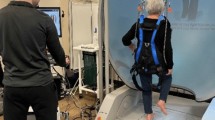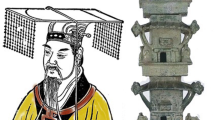Abstract
After a period of stepping on a rotating platform, blindfolded subjects demonstrate a tendency to unconsciously turn when stepping in place, an after-effect known as podokinetic after-rotation (PKAR). Recent studies have also reported a change in postural orientation following the adaptive period and have suggested that this is causally related to PKAR. Here, we assess changes in trunk orientation following platform adaptation and determine their relationship to PKAR. Specifically, we determine whether a reorganized standing posture causes PKAR. Ten subjects stepped on a platform rotating at 60°/s for 10 min, with a cadence of 100 steps/min. Following adaptation, a significant PKAR response was seen, with a mean yaw rotation velocity of 6.0 ± 2.2°/s. In addition to this dynamic after-effect, there was a significant twist of the trunk with respect to the feet when standing still (6.9° ± 4.5°; mean ± SD), confirming the presence of a postural reorientation after-effect. However, the magnitudes of the two after-effects did not correlate (r = 0.06, p = 0.87). Furthermore, in a second experiment, a prolonged passive twist of the trunk was used to induce postural reorientation. However, in this case, PKAR was not induced. These results demonstrate that PKAR is not an automatic consequence of reorganized standing posture.




Similar content being viewed by others
References
Earhart GM, Jones GM, Horak FB, Block EW, Weber KD, Fletcher WA (2001) Forward versus backward walking: transfer of podokinetic adaptation. J Neurophysiol 86:1666–1670
Earhart GM, Fletcher WA, Horak FB, Block EW, Weber KD, Suchowersky O, Jones GM (2002) Does the cerebellum play a role in podokinetic adaptation? Exp Brain Res 146:538–542
Earhart GM, Sibley KM, Horak FB (2004) Effects of bilateral vestibular loss on podokinetic after-rotation. Exp Brain Res 155:251–256
Gordon CR, Fletcher WA, Jones GM, Block EW (1995) Adaptive plasticity in the control of locomotor trajectory. Exp Brain Res 102:540–545
Gregory JE, Morgan DL, Proske U (1988) Aftereffects in the responses of cat muscle-spindles and errors of limb position sense in man. J Neurophysiol 59:1220–1230
Guerraz M, Navarro J, Ferrero F, Cremieux J, Blouin J (2006) Perceived versus actual head-on-trunk orientation during arm movement control. Exp Brain Res 172:221–229
Gurfinkel VS, Popov KE, Smetanin BN, Shlykov VY (1989) Changes in the direction of vestibulomotor response in the course of adaptation to protracted static head turning in man. Neurophysiology 21:159–164
Held R (1965) Plasticity in sensory-motor systems. Sci Am 213:84
Hollands MA, Young WR, Chapman GJ (2007) The effects of podokinetic conditioning on static and dynamic posture. In: International society for posture and gait research 18th international conference abstracts, vol 154
Ivanenko YP, Wright WG, Gurfinkel VS, Horak F, Cordo P (2006) Interaction of involuntary post-contraction activity with locomotor movements. Exp Brain Res 169:255–260
Jahn K, Kalla R, Karg S, Strupp M, Brandt T (2006) Eccentric eye and head positions in darkness induce deviation from the intended path. Exp Brain Res 174:152–157
Juergens R, Boss T, Becker W (1999) Podokinetic after-rotation does not depend on sensory conflict. Exp Brain Res 128:563–567
Kluzik J, Horak FB, Peterka RJ (2005) Differences in preferred reference frames for postural orientation shown by after-effects of stance on an inclined surface. Exp Brain Res 162:474–489
Kluzik J, Horak FB, Peterka RJ (2007a) Postural after-effects of stepping on an inclined surface. Neurosci Lett 413:93–98
Kluzik J, Peterka RJ, Horak FB (2007b) Adaptation of postural orientation to changes in surface inclination. Exp Brain Res 178:1–17
Mars F, Honore J, Richard C, Coquery JM (1998) Effects of all illusory orientation of the head on straight-ahead pointing movements. Curr Psychol Cognit 17:749–762
Morgan DL, Prochazka A, Proske U (1984) The aftereffects of stretch and fusimotor stimulation on the responses of primary endings of cat muscle-spindles. J Physiol Lond 356:465–477
Proske U, Morgan DL, Gregory JE (1993) Thixotropy in skeletal-muscle and in muscle-spindles: a review. Prog Neurobiol 41:705–721
Reynolds RF (2011) Vertical torque responses to vestibular stimulation in standing humans. J Physiol Lond 589:3943–3953
Scott JT, Lohnes CA, Horak FB, Earhart GM (2011) Podokinetic stimulation causes shifts in perception of straight ahead. Exp Brain Res 208:313–321
Toussaint Y, Do MC, Fagard J (2008) What are the factors responsible for the deviation in stepping on the spot? Neurosci Lett 435:60–64
Vallbo AB (1970) Discharge patterns in human muscle spindle afferents during isometric voluntary contractions. Acta Physiol Scand 80:552–566
Weber KD, Fletcher WA, Gordon CR, Jones GM, Block EW (1998) Motor learning in the “podokinetic” system and its role in spatial orientation during locomotion. Exp Brain Res 120:377–385
Winter JA, Allen TJ, Proske U (2005) Muscle spindle signals combine with the sense of effort to indicate limb position. J Physiol Lond 568:1035–1046
Wong CM, Hong M, Earhart GM (2007) Limited transfer of podokinetic after-rotation from kneeling to standing. Somatosens Mot Res 24:35–40
Acknowledgments
We thank Dr Mark Hollands for equipment use and Steve Allen for technical assistance. CJO is supported by the BBSRC.
Author information
Authors and Affiliations
Corresponding author
Rights and permissions
About this article
Cite this article
Osler, C.J., Reynolds, R.F. Postural reorientation does not cause the locomotor after-effect following rotary locomotion. Exp Brain Res 220, 231–237 (2012). https://doi.org/10.1007/s00221-012-3132-6
Received:
Accepted:
Published:
Issue Date:
DOI: https://doi.org/10.1007/s00221-012-3132-6




